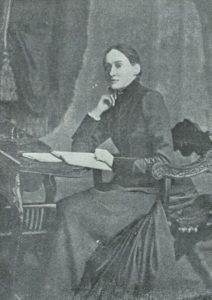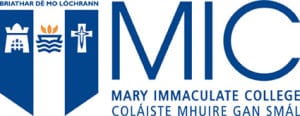Recovering Irish Women Writers: Lady Virginia Sandars, a Contemporary of Wilde, Hardy and Kipling
Dr Paul O’Brien (MIC, Limerick)
Lady Virginia Sandars (17 March 1828 – 26 January 1922)
Lady Virginia Frances Zerlina Taylour was the youngest daughter of Thomas Taylour, the 2nd Marquess of Headfort and Olivia Stevenson. A member of the Anglo-Irish ascendancy, Virginia lived in the large, eleven-bay Robert Adam designed, Headfort House in County Meath. Her father, Thomas Taylour, 2nd Marquess of Headfort, was connected through marriage to the Earl of Dunraven and the Earl of Spencer. The vast Taylour estate amounted to 20,000 acres in Cavan and Meath. Taylour represented Kells in the Irish parliament from 1776 to 1790, subsequently sitting as MP for Longford until 1794 and Meath until 1795.

In 1850, Virginia married Joseph Sandars MP (1821-1893) of Henley-on-Thames, Buckingham. Sandars was the son of a wealthy corn merchant based in Liverpool, typical of the rising industrial class of the mid-to-late-nineteenth century. His family resided at Taplow House, Bucks. Sandars was educated at Downing College, Cambridge and was MP for Yarmouth 1848-52, residing with Virginia at 15 Eaton Square, S.W.[1] The Sandars, as leading members of London society, were noted for their extravagant house parties which were well-attended by the upper echelons of society, regular visitors including the Earl and Countess of Bradford, Duke of Newcastle, the Duke of Westminster and the Marquis of Hartington.[2] Such soirées clearly influenced Virginia’s literary output which featured earls, dukes and ladies and their activities and interactions in society. Her books were favourably reviewed in the Spectator, though a review of her first book, The Heiress of Haredale, was particularly harsh. Published in John Bull, it suggested Sandars’ work was ‘a novel of a somewhat conventional type…she will never reach the more exalted rank among writers of fiction; and though her first venture will not be an unwelcome addition to what we call seaside novels, there is no chance of it surviving more than one, or, at the most, two seasons.’[3]
In 1851, her brother, Lord Robert Taylour, died at the barracks in Fermoy, Co. Cork. Taylour was engaged in an argument with an individual who was beating a dog. A fight ensued and Taylour was struck – he died some days later.[4] In 1858, the noted Irish miniature painter, Elish Lamont (c.1800/1816-1870), produced a miniature of Lady Virginia Sandars, R.H.A.[5]
Like many women of her class, Sandars patronised local charities and in 1879 performed several songs with Miss Tayleur [sic] in Flintshire, the proceeds from which aided a plethora of local charities.[6] Sandars also sat on the management board of the pioneering Madame Devey’s Company, founded by women for the protection of women, and which endeavoured to protect female workers involved in the West End dressmaking and millinery trade from working excessive hours. The company described how ‘every London season was inaugurated by the death of one or more victims, who had succumbed under the terrible labours to which they were subjected by the caprice of fashion.’[7] Sandars was also involved in political circles through her membership of the Conservative Primrose League, in 1887 being recorded as attending a League meeting supporting Lord Salisbury’s Irish policy.[8]

In 1892, the Taunton Courier and Western Advertiser reported that Read’s County Library had acquired ‘sixty-nine works which are now in the course of circulation among subscribers’, the topics varying from fiction to travel accounts.[9] Of these texts, thirteen were written by female authors, while the names of several well-known Victorian male writers (among them Thomas Hardy, Rudyard Kipling and Arthur Conan Doyle) were also prominent on the list. Situated alongside works by famous women writers such as Charlotte Brontë and Mrs Hungerford was A Life’s Devotion by Lady V. Sandars.[10] Sandars not only authored several books and short stories but also contributed to literary magazines and journals, most notably Belgravia, founded in 1866 by Mary Elizabeth Braddon (1837-1915), which initially published sensation fiction. However, its acquisition in 1876 by Chatto & Windus steered it towards works by established authors including Mark Twain, ensuring that Sandars’ piece, ‘A Story of the People’s Palace’, published in that journal in 1890, reached a wide and discerning audience.[11]
Among Lady Virginia Sandars’ most noteworthy full-length publications are The Heiress of Haredale: A Novel (1886); The Duke of Melton (1887); A Bitter Romance (1888) and A Life’s Devotion (1891). Her contributions to high profile magazines of the period include ‘A Story of Cowes Regatta’ in The Argosy (1886) and an essay entitled ‘Love’s Absolution: or an episode of London’s Life’ in The Woman’s World (1888) a magazine edited by Oscar Wilde.
Lady Virginia Sandars died in Walton Street, London in 1922, at the age of 92. Her funeral took place at Husbands Bosworth.[12]
Paul O’Brien received his doctorate from the Department of History at Mary Immaculate College, University of Limerick, where he lectures in the Academic Learning Centre. In 2016, he was a research fellow at Centre Culturel Irlandais, Paris. He is a recipient of the Military Heritage Trust of Ireland award for his research into recruitment practices during the First World War. In 2019 he published a monograph based on this doctoral thesis The Glynns of Kilrush, County Clare, 1811–1940: Family, business, and politics (Four Courts Press, Dublin). Paul is currently writing a book on the life and times of Lady Victoria Pery (1893-1918) an early aviatrix.
Would you like to submit a blogpost? Check out our guidelines here or email Dr Deirdre Flynn.
Bibliography
Brake, L. and Demoor, M., Dictionary of Nineteenth-century Journalism in Great Britain and Ireland (Gent, 2009).
Edwards, P.D., Sibley, I.G. and Versteeg, M., Belgravia: Victorian Fiction Research Guides XIV (Queensland, 1989).
Mooney, J., The changing fortunes of the Headfort estates, 1870–1928 (Dublin, 2012).
National Library of Ireland, Headfort Estate Papers (Additional): Estate records and personal and political papers of the Taylour family, Marquesses of Headfort, ca. 1600–1980. (Mss 42,068, 42,080, 48, 541–49, 110 & 49, 136).
Sandars, V. (1886) The Heiress of Haredale: A Novel. 3 vol. London: F. V. White.
– (1887) The Duke of Melton, London: White and Co.
– (1888) A Bitter Repentance. 3 vol. London: Hurst and Blackett.
– (1891) A Life’s Devotion. 3 vol. London: Hurst and Blackett.
Sandars, V. ‘A Story of the People’s Palace’ in Belgravia (1890), pp. 47-67.
– ‘A story of Cowes Regatta’ in The Argosy (1886)
Walford, E. W., The county families of the United Kingdom (London, 1860).
Walter G. Strickland, Dictionary of Irish Artists (Dublin, 1913).
Newspapers
- Illustrated London News.
- Market Harborough Advertiser and Midland Mail.
- Morning Post.
- Portsmouth Times and Naval Gazette.
- Reading Mercury.
- St. James Gazette.
- Taunton Courier, and Western Advertiser.
- Wrexham Guardian and Denbighshire and Flintshire Advertiser.
[1] E. W. Walford, The county families of the United Kingdom (London, 1860), p. 793.
[2] Morning Post, 30 May 1867.
[3] St James’s Gazette, 1 September 1886; John Bull, 4 September 1886.
[4] Portsmouth Times and Naval Gazette, 25 January 1851.
[5] Walter G. Strickland, Dictionary of Irish Artists (Dublin 1913).
[6] Wrexham Guardian and Denbighshire and Flintshire Advertiser, 6 September 1879.
[7] Taunton Courier, and Western Advertiser, 5 May 1880.
[8] Reading Mercury, 30 April 1887.
[9] Ibid.
[10] Taunton Courier, and Western Advertiser, 16 March 1892.
[11] Laurel Brake and Marysa Demoor, Dictionary of Nineteenth-century Journalism in Great Britain and Ireland (Gent, 2009), pp. 44-45.
[12] Market Harborough Advertiser and Midland Mail, 7 February 1922.



